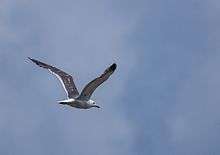Heuglin's gull
| Heuglin's gull | |
|---|---|
| | |
| In the Kachchh region of India, resting in a saltpan. | |
| Scientific classification | |
| Kingdom: | Animalia |
| Phylum: | Chordata |
| Class: | Aves |
| Order: | Charadriiformes |
| Family: | Laridae |
| Genus: | Larus |
| Species: | L. heuglini |
| Binomial name | |
| Larus heuglini Bree, 1876, north Siberia | |

Heuglin's gull or Siberian gull (Larus heuglini) is a seabird in the genus Larus. It is closely related to the lesser black-backed gull (Larus fuscus) and is often classified as a subspecies of it. It has also been included within the herring gull (Larus argentatus).
Birds in the eastern part of Heuglin's gull's range are often paler grey above and are frequently considered to be a separate subspecies Larus heuglini taimyrensis (Taimyr gull). Another possibility is that they are a result of hybridization between Heuglin's gulls and Vega gulls.
Heuglin's gulls breed in the tundra of northern Russia from the Kola Peninsula east to the Taymyr Peninsula. They are regularly reported from Finland and may breed there. They migrate south to winter in Southwest Asia, the Indian Subcontinent, East Asia, and East Africa. Small numbers are seen in Southeast Asia, it has been recorded in South Africa and it may occur as a vagrant in Western Europe.
They are large gulls with a rounded head, strong bill and long legs and wings. Length is from 53 to 70 cm (21 to 28 in), wingspan is from 138 to 158 cm (54 to 62 in) and body mass is from 745 to 1,360 g (1.642 to 2.998 lb).[1] Among standard measurements, the wing chord is 40.5 to 46.9 cm (15.9 to 18.5 in), the bill is 4.5 to 6.5 cm (1.8 to 2.6 in) and the tarsus is 5.9 to 7.8 cm (2.3 to 3.1 in).[1] The back and wings are dark grey, variable in shade but often similar to the graelsii race of the slightly smaller lesser black-backed gull. In winter the head is only lightly streaked with brown but there is heavier streaking on the hindneck. The legs are usually yellow but can be pink.
Moulting takes place later than in most of their relatives so birds still have unstreaked heads and worn primaries in September and October. The primary feathers may not be fully grown until February or March when the head is still streaked.
They feed mainly on molluscs, worms, and crustaceans.
References
- Paul Doherty & Bill Oddie (2001) Gulls: A Video Guide to the Gulls of Europe, Asia & North America. Videocassette. Bird Images.
- Klaus Malling Olsen & Hans Larsson (2003) Gulls of North America, Europe, and Asia, Princeton University Press.
- Craig Robson (2002) A Field Guide to the Birds of South-East Asia. New Holland, London.
- Adrian Skerrett, Ian Bullock & Tony Disley (2001), Birds of Seychelles, Christopher Helm, London.
External links
- Heuglin's Gull, Gull Research Organization
- The "Herring Gull" Assemblage in South Korea, Birding Korea
